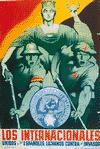- International Brigades
-
Groups of foreign volunteers who fought on the Republican side against the Nationalist forces in the Spanish Civil War (1936–39).So-called because their members initially came from some 50 countries, the International Brigades were recruited, organized, and directed by the Comintern, with headquarters in Paris. The U.S. contingent called itself the Abraham Lincoln Batallion. Many of the mostly young recruits were communists before they became involved in the conflict; more joined the party during the course of the war. The total number of volunteers reached about 60,000. The brigades were formally withdrawn from Spain late in 1938.
 "The InternationalsUnited with the Spaniards We Fight the Invader," poster by ...Courtesy of the Abraham Lincoln Brigade Archives, Brandeis University Library
"The InternationalsUnited with the Spaniards We Fight the Invader," poster by ...Courtesy of the Abraham Lincoln Brigade Archives, Brandeis University Library* * *
▪ military forcegroups of foreign volunteers who fought on the Republican side against the Nationalist forces during the Spanish Civil War (1936–39). So called because their members (initially) came from some 50 countries, the International Brigades were recruited, organized, and directed by the Comintern (International, Third) (Communist International), with headquarters in Paris. A large number of the mostly young recruits were Communists before they became involved in the conflict; more joined the party during the course of the war. The French were the largest single foreign group (some 28,000); Germany, Austria, Poland, Italy, the United States, the United Kingdom, Yugoslavia, Czechoslovakia, Canada, Hungary, and Belgium were also represented by significant numbers of volunteers.The first group of 500 trainees arrived in Albacete, Spain, on October 14, 1936. As other trainees and Soviet arms arrived, they were placed under the command of representatives of the Comintern. There were seven brigades in all, and each one was divided into battalions by nationality (e.g., the French-Belgian Commune de Paris Battalion, the American Abraham Lincoln Battalion, the British Battalion). The number of volunteers probably never exceeded 20,000 at any one time, but the total number of volunteers, including a small number of women, reached about 60,000.From 1936 to 1938 the brigades, despite some difficulties, operated effectively on the Republican side, and their organization was imitated by other units of the Republican army. From 1937 on, recruits for the brigades diminished, and men lost in action or by desertion were replaced mainly by Spanish Communists. The brigades were formally withdrawn from Spain late in 1938 as part of Prime Minister Juan Negrín (Negrín López, Juan)'s attempt to win British and French support for his government. The last battle in which they participated was that of the Ebro. A farewell parade was held for the volunteers in Barcelona, Spain, on November 15, 1938.* * *
Universalium. 2010.
